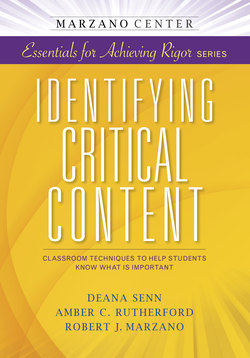Читать книгу Identifying Critical Content: Classroom Techniques to Help Students Know What is Important - Deana Senn - Страница 9
На сайте Литреса книга снята с продажи.
ОглавлениеIntroduction
This guide, Identifying Critical Content: Classroom Techniques to Help Students Know What Is Important, is intended as a resource for improving a specific element of instructional practice—identifying critical content. Your motivation to incorporate this strategy into your instructional toolbox may have come from a personal desire to improve your instructional practice through the implementation of a research-based set of strategies (such as those found in the Marzano teacher evaluation framework) or a desire to increase the rigor of the instructional strategies you implement in your class so that students meet the expectations of demanding standards such as the Common Core State Standards, Next Generation Science Standards, C3 Framework for Social Studies State Standards, or state standards based on or influenced by College and Career Readiness Anchor Standards.
This guide will help teachers of all grade levels and subjects improve their performance of a specific instructional strategy: identifying critical content. Narrowing your focus on a specific skill, such as identifying critical content, allows you to concentrate on the nuances of this instructional strategy in order to deliberately improve it. This allows you to intentionally plan, implement, monitor, adapt, and reflect on this single element of your instructional practice. A person seeking to become an expert displays distinctive behaviors, as explained by Marzano and Toth (2013):
• breaks down the specific skills required to be an expert
• focuses on improving those particular critical skill chunks (as opposed to easy tasks) during practice or day-to-day activities
• receives immediate, specific, and actionable feedback, particularly from a more experienced coach
• continually practices each critical skill at more challenging levels with the intention of mastering it, giving far less time to skills already mastered
This series of guides will support each of the above-listed behaviors, with a focus on breaking down the specific skills required to be an expert and giving day-to-day practical suggestions to enhance these skills.
Building on the Marzano Instructional Framework
This series is based on the Marzano instructional framework, which is grounded in research and provides educators with the tools they need to connect instructional practice to student achievement. The series uses key terms that are specific to the Marzano model of instruction. Table 1 provides a glossary of these key terms.
Table 1. Glossary of Key Terms
| Term | Definition |
| CCSS | Common Core State Standards is the official name of the standards documents developed by the Common Core State Standards Initiative (CCSSI), the goal of which is to prepare America’s students for college and career. |
| CCR | College and Career Readiness Anchor Standards are broad statements that incorporate individual standards for various grade levels and specific content areas. |
| Desired result | The intended result for the student(s) due to the implementation of a specific strategy. |
| Monitoring | The act of checking for evidence of the desired result of a specific strategy while the strategy is being implemented. |
| Instructional strategy | A category of techniques used for classroom instruction that has been proven to have a high probability of enhancing student achievement. |
| Instructional technique | The method used to teach and deepen understanding of knowledge and skills. |
| Content | The knowledge and skills necessary for students to demonstrate standards. |
| Scaffolding | A purposeful progression of support that targets cognitive complexity and student autonomy to reach rigor. |
| Extending | Activities that move students who have already demonstrated the desired result to a higher level of understanding. |
The educational pendulum swings widely from decade to decade. Educators move back and forth between prescriptive checklists and step-by-step lesson plans to approaches that encourage instructional autonomy with minimal regard for the science of teaching and need for accountability. Two practices are often missing in both of these approaches to defining effective instruction: 1) specific statements of desired results, and 2) solid research-based connections. The Marzano instructional framework provides a comprehensive system that details what is required from teachers to develop their craft using research-based instructional strategies. Launching from this solid instructional foundation, teachers will then be prepared to merge that science with their own unique, yet effective, instructional style, which is the art of teaching.
Identifying Critical Content: Classroom Techniques to Help Students Know What Is Important will help you grow into an innovative and highly skilled teacher who is able to implement, scaffold, and extend instruction to meet a range of student needs.
Essentials for Achieving Rigor
This series of guides details essential classroom strategies to support the complex shifts in teaching that are necessary for an environment where academic rigor is a requirement for all students. The instructional strategies presented in this series are essential to effectively teach the CCSS, the Next Generation Science Standards, or standards designated by your school district or state. They require a deeper understanding, more effective use of strategies, and greater frequency of implementation for your students to demonstrate the knowledge and skills required by rigorous standards. This series includes instructional techniques appropriate for all grade levels and content areas. The examples contained within are grade-level specific and should serve as models and launching points for application in your own class.
Your skillful implementation of these strategies is essential to your students’ mastery of the CCSS or other rigorous standards, no matter the grade level or subject matter you are teaching. Instructional strategies such as Examining Reasoning and Engaging Students in Cognitively Complex Tasks exemplify the cognitive complexity needed to meet rigorous standards. Taken as a package, these strategies may at first glance seem quite daunting. That is why this series focuses on just one strategy in each guide.
